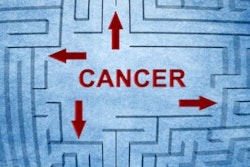
The debate over the potential harms of CT radiation carries on in a new study published online March 10 in Radiology. Researchers from Japan are reporting that they found no evidence of DNA damage in individuals who underwent low-dose CT scans -- while damage was detectable from standard-dose exams.
Whether current levels of radiation dose from medical imaging exams are high enough to cause negative health effects remains controversial.
Previous risk analyses have reported that the lifetime risk of cancer from a head CT scan is markedly lower than the estimated lifetime cancer risk in the general population. Yet studies have also uncovered an association between radiation-based diagnostic imaging exams and an increased incidence of cancer. This uncertainty has raised concerns among individuals who are considering CT lung cancer screening and other exams that involve radiation exposure.
In the current prospective study, Dr. Satoshi Tashiro, PhD, and colleagues from Hiroshima University investigated the biological effect of standard CT and low-dose CT scanning on human DNA. They acquired peripheral blood samples from 209 individuals before and 15 minutes after they underwent a chest CT exam. Roughly half of the individuals received standard CT (mean effective dose of 5 mSv) and the other half low-dose CT (1.5 mSv) -- the type of exam used for lung cancer screening.
 Immunofluorescence staining of DNA samples from an 82-year-old woman obtained within 15 minutes after undergoing standard CT. The images show the nuclear DNA of four lymphocytes (a); isolated γ-H2AX foci, a marker of DNA double-strand breaks (b); and lymphocytes with γ-H2AX foci (c). Scale bar: 5 mm. Image courtesy of the RSNA.
Immunofluorescence staining of DNA samples from an 82-year-old woman obtained within 15 minutes after undergoing standard CT. The images show the nuclear DNA of four lymphocytes (a); isolated γ-H2AX foci, a marker of DNA double-strand breaks (b); and lymphocytes with γ-H2AX foci (c). Scale bar: 5 mm. Image courtesy of the RSNA.The researchers found that there was a statistically significant increase in the number of DNA double-strand breaks (p < 0.001) and chromosome aberrations (p = 0.003) in individuals after undergoing a standard CT exam, compared with before the exam. Conversely, there were no statistically significant increases in DNA damage and chromosome aberrations in the individuals who underwent a low-dose CT exam.
| Effect of radiation from standard CT vs. low-dose CT on DNA samples | ||
| Standard CT | Low-dose CT | |
| Mean effective radiation dose | 5 mSv | 1.5 mSv |
| Increase in DNA double-strand breaks after CT | 0.05 γ-H2AX foci per cell* | 0.02 γ-H2AX foci per cell |
| Increase in chromosome aberrations after CT | 2.1 per person* | 0.5 per person |
"We could clearly detect the increase of DNA damage and chromosome aberrations after standard chest CT," Tashiro said in a statement. "In contrast, no significant differences were observed in these biological effects before and after low-dose CT."
In a secondary analysis, the researchers tracked the effect of CT radiation on 63 individuals from the original cohort who underwent a follow-up standard CT exam within three months after their initial low-dose CT exam.
They discovered that standard CT led to statistically significant increases in DNA damage (p = 0.01) and chromosome aberrations (p = 0.009) in all these individuals, none of whom demonstrated statistically significant increases in either abnormality after their initial low-dose CT exam.
Highly sensitive DNA analyses were unable to detect any negative biological effects of low-dose CT, suggesting that the "application of low-dose CT for lung cancer screening is justified from a biological point of view," Tashiro said in a statement.
Following the study, the researchers plan to use their biological analysis to explore the effects of other radiation-based imaging modalities on DNA.
"We are interested in the biological effects of various types of radiological diagnosis, including PET/CT, to establish a better system for the management of medical radiation exposure," he said.


















